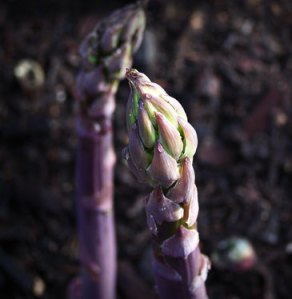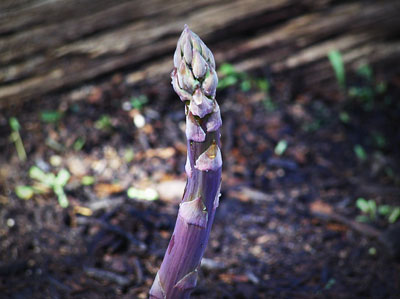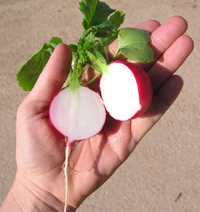
Purple Asparagus in our Garden
As we wrote on twitter this morning: the purple asparagus in our garden never makes it to the kitchen. We eat the spears immediately after harvesting.
Through out early April, we anticipate savoring these treats from our garden. Sweet, fresh, mild – this asparagus is our kind of candy.
Purple asparagus tastes sweeter than it’s green cousin because it’s higher in sugar content than green asparagus. What makes them purple? Cancer fighting phytochemicals called Anthocyanins are responsible for their beautiful purple hue.
Asparagus is well known for its medicinal properties. Asparagus is a diuretic and laxative with a beneficial effect on the kidneys, liver and bowels. Nutritionally, asparagus is rich in vitamins C & E, folate, potassium, and fiber.
Nutrition Data for Raw Asparagus
Growing Asparagus
About five years ago, we planted one-year-old purple asparagus crowns (rhizomes) in March, when the freezing weather had past. Asparagus is a deep-rooted crop that prefers a soil pH of 6.5-7.5. We planted them in a slightly raised bed filled with nice loamy soil incorporated with plenty of organic compost and a mix of chicken and goat manure.
Asparagus is long-lived crop that can be productive for 15 years or more if well tended. We are sure to mulch and water the asparagus well through out the year (water logging isn’t a problem here in the desert). Every early February, after we clip away the fern debris, we lightly scratch in a 2-inch thick layer of organic steer manure over the entire asparagus bed.
A year later we were able to harvest our first purple asparagus. The best moment to harvest asparagus is when they are the width of one’s thumb, and a height of about six to eight inches. We prefer to cut the spear with a knife at the soil surface.
At the end of the harvest season, we leave a few mature spears to grow out. These asparagus spears will grow into a beautiful, tall fern, re-charging its crown for the next harvest season. During the late season, our female plants bear red seed-bearing fruits.
Treat yourself to this wonderful vegetable. Now is the time to put your asparagus crowns into the soil.
With consistent care and patience, asparagus will reward you every spring with spears bursting with flavor and nourishment for many years to come.

Purple Asparagus in our Garden
Tags: anthocyanin, fern, growing, nutrition, organic garden, purple asparagus, rhizomes, Soil, spears








 We're eclectic organic gardeners – growing, tinkering, writing, arting, soldering, and eating in the Arizona Sonoran Desert.
We're eclectic organic gardeners – growing, tinkering, writing, arting, soldering, and eating in the Arizona Sonoran Desert.






Recent Comments